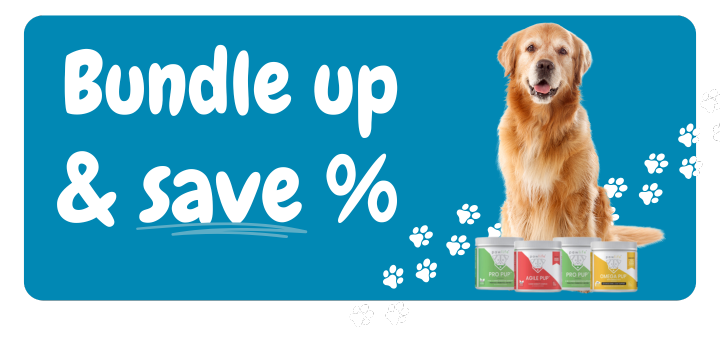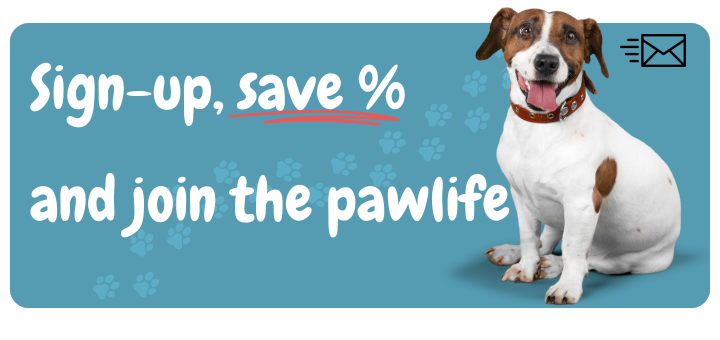Creating Lasting Calm Through Routine, Nutrition, and Care
Just like people, dogs experience stress for lots of reasons—loud fireworks, long days alone, new environments, or even changes in routine. Anxiety can show up as barking, pacing, hiding, or destructive chewing, but beneath the behavior is a worried pup asking for help. The good news is that most dogs respond beautifully to a blend of predictable routines, enrichment, positive-reinforcement training, and gentle, natural calming support. When you pair lifestyle changes with smart nutrition and targeted supplements, you can help your dog feel safe, confident, and relaxed day after day.
At Pawlife Pets, we take a whole-dog approach to emotional wellness. For everyday calm, many pet parents start with Calm Pup. For dogs with stress plus tummy flares, the Calm Comfort Duo layers calming botanicals with gut support. And if your anxious pup also struggles with stiffness, Comfort Move Duo supports relaxation and joint comfort together.
Clear Signs Your Dog May Be Feeling Anxious
Dogs communicate stress in different ways, and subtle patterns matter as much as big reactions. Watch for clusters of behaviors that repeat across similar situations, such as separation, storms, or visitors.
- Vocalizing and restlessness: Excessive barking, whining, panting, pacing, or inability to settle even in a quiet room.
- Withdrawn or clingy behavior: Hiding under furniture, shadowing you from room to room, or refusing to explore familiar spaces.
- Destructive outlets: Chewing doors, baseboards, bedding, or toys during specific stress windows (e.g., when you leave for work).
- House-soiling “out of the blue”: Accidents despite being potty trained, particularly after noises or schedule changes.
- Body language shifts: Trembling, tucked tail, pinned ears, lip licking, yawning, or whale eye during triggers.
If you’re seeing these signs weekly—or in spikes around known triggers—it’s time to build a calm-first plan. For complementary tips, see Seven Ways to Calm an Anxious Dog for additional home strategies.
Common Triggers Behind Dog Anxiety (and How to Spot Them)
Some dogs are naturally sensitive, but most anxiety maps to predictable stressors. Tracking what happened before the behavior will help you tailor solutions that work.
- Separation and schedule changes: Alone time, back-to-office routines, or inconsistent departures and returns.
- Noise sensitivity: Thunderstorms, fireworks, construction, or even loud TV. For storm-specific help, read How to Calm Your Dog During Thunderstorms.
- Environmental shifts: Moving, travel, visitors, new pets, or changing furniture/layouts.
- Physical discomfort: Pain amplifies fear responses. If your anxious dog also seems stiff, see The Ultimate Guide to Dog Joint Health.
- Gut imbalance: GI upsets can heighten reactivity; learn the skin-gut-mood connection in Digestive Wellness for Dogs.
Build a Calming Lifestyle: Daily Habits That Lower Stress
Many dogs relax faster once the day feels predictable and engaging. These foundation habits reduce nervous energy while teaching your pup that the world is safe and understandable.
- Structured exercise: Daily walks and play sessions help burn adrenaline and boost feel-good endorphins. Layer in short sniff walks to promote decompression.
- Enrichment and puzzle play: Food-puzzles, lick mats, and safe chews direct anxious energy into focus and problem-solving.
- Calm routines: Consistent feed, walk, and rest times anchor the day. A predictable pre-departure ritual helps with goodbyes.
- Crate or cozy den: A covered crate or quiet corner with a bed and your scent can become a safe retreat during triggers.
- Gradual desensitization: Pair tiny doses of the trigger (recorded thunder at low volume, short alone-time reps) with rewards to rewire fear into neutrality.
For a weekly wellness cadence across ages, check Daily Supplement Routines for Dogs.
Natural Calming Ingredients That Help Without Sedation
When you need extra support, gentle botanicals and amino acids can smooth the edges of reactivity while keeping your dog alert and engaged. Look for synergistic blends that address calm, focus, and resilience together.
- Chamomile & passionflower: Time-tested botanicals that ease tension and settle nervous systems naturally.
- Valerian root: Helps with relaxation and restful downtime during high-stress periods.
- L-Theanine: Green-tea amino acid for calm focus—great for training through triggers.
- Magnesium & amino blends: Support neuromuscular relaxation and a steady mood.
Calm Pup soft chews combine dog-friendly calming nutrients in a tasty daily format that’s easy to keep consistent. For pups whose anxiety shows up as tummy issues (loose stool, nausea, grass eating), the Calm Comfort Duo supports both calm and gut balance.
A Holistic Calm Plan: Routine, Nutrition, and Targeted Support
Calm isn’t a single product—it’s a system. Use the steps below as your blueprint, then tweak based on your dog’s unique triggers and response.
- Anchor the day: Set fixed meal, walk, and rest windows. Add two short training bursts to build confidence.
- Move and decompress: Alternate brisk activity with sniff walks or foraging games to meet body and brain needs.
- Daily calm support: Give Calm Pup 30–60 minutes before known stress (departures, storms, visitors).
- Balance the gut: Pair calm with digestion support if stress upsets the tummy: see Calm Comfort Duo or add Pro Pup probiotics.
- Layer long-term wellness: Omega-3s from Wild Alaskan Salmon Oil support brain health, skin comfort, and joint mobility—key for calmer, happier movement.
Shopping by need? Explore Calming, Digestion, and Skin & Coat collections to build your dog’s custom routine.
Training Through Triggers: A Simple Desensitization Framework
Training is where calm turns into confidence. The goal is not to “flood” your dog with scary stuff, but to pair tiny, tolerable doses of the trigger with something your dog loves, like high-value treats or a favorite toy.
- Find the threshold: Play a thunder sound at a barely audible volume, or step just outside the door for 10 seconds—whatever your dog can handle without escalating.
- Pair and pay: When the trigger appears at that tiny dose, feed multiple small treats and speak calmly; when it stops, the treats stop.
- Advance slowly: Over days and weeks, raise the volume or duration by small increments as long as your dog stays relaxed and engaged.
- Track progress: Keep a short log of settings and your dog’s body language so you can see steady gains.
Need help picking the right rewards or timing? Our post on Keeping Your Pup Calm with Guests includes simple reinforcement ideas you can borrow year-round.
When Anxiety Meets Discomfort: Supporting the Body to Calm the Mind
Dogs struggling with soreness or inflammation often show more irritability, avoidance, and noise sensitivity. If your anxious dog hesitates on stairs or seems stiff after naps, supporting mobility can reduce overall reactivity.
For proactive joint support, see Agile Pup, and consider bundle options like Comfort Move Duo. You can also review warm-up ideas and prevention tips in How to Recognize When Your Dog Needs a Mobility Supplement.
Nutrition, Gut Balance, and the Calm-Skin Connection
The gut-brain-skin axis is real: GI imbalance can drive mood swings, and chronic itching can raise stress. If your anxious pup also has soft stool, grass eating, or seasonal itch, consider rounding out their plan with digestion and skin-coat support.
- Daily probiotics: Pro Pup helps stabilize the microbiome for calmer tummies and steadier moods.
- Omega-3s for brain + skin: Wild Alaskan Salmon Oil supports cognitive calm and comfortable skin.
- Immune balance: Immune Pup can help reduce overreactions to environmental allergens that often flare anxiety. For more skin tips, read Helpful Remedies for Dry, Itchy Skin.
FAQ: Quick Answers for Calmer Days
How long before Calm Pup takes effect?
Most dogs begin to “soften” within 30–60 minutes. For big events (travel, storms), give earlier and consider a second, label-safe dose window. Consistency builds calmer baselines over 1–2 weeks.
Can I use calming supplements daily?
Yes—gentle, non-sedating ingredients are designed for everyday use. Daily routines (plus training) typically produce the best long-term results.
What if my dog is anxious and has a sensitive stomach?
Try the Calm Comfort Duo or pair Calm Pup with Pro Pup to support both calm and digestion.
Should I loop in my veterinarian?
Definitely—especially if anxiety appears suddenly or severely. Your vet can rule out pain or medical drivers, and help you combine training, environment changes, and natural support safely.
Calm Starts Today: Build Your Pup’s Personalized Plan
The most effective anxiety plans blend structure, enrichment, gentle nutrients, and patient training. Start small, stay consistent, and adjust based on your dog’s feedback. To save on bundles as you build your routine, you can use the current code K9SAVE30 where applicable: explore All Products or jump to Calming, Digestion, and Skin & Coat.
👉 Ready to help your dog feel safe and settled? Try Calm Pup for everyday ease, or choose Calm Comfort Duo to support both calm and digestion.













